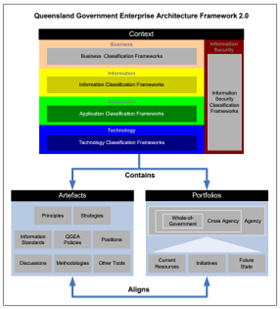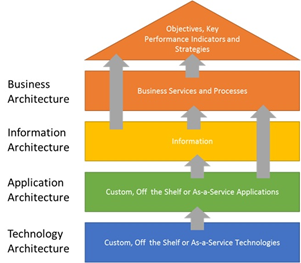by Dr Christine Stephenson
I know that many of you would have asked yourself this question before – what makes a good Enterprise Architecture. You may also have wondered what a good enterprise architecture looks like?
This might come across as an incredibly biased article, because I am going to show you what a good enterprise architecture is and also what a good one looks like. Why is it biased? Well, I was one of the authors of this Enterprise Architecture.
Close to 20 years ago, three of my colleagues and I were ‘locked in a room’ for a week and told not to come out till we had an Enterprise Architecture for the Queensland Government.
My colleagues Ee Kuan Low, Don Ashdown, Paul York and I, had been generously given time to research what other government enterprise architectures looked like. At the time the only show cases were the US, UK and Singapore Governments.
We did a LOT of reading, met a LOT of people who were thought leaders in the world of Enterprise Architecture, John Zachman – everyone knows him, Michael Tieman, of FEAC fame…to name drop some biggies.
What we did right? Designed the Enterprise Architecture with a clear purpose in mind. The Queensland Government’s strategy was very clear, “Agencies must align with the GEA by 2020”. OK, what did that mean? We didn’t have a GEA (Government Enterprise Architecture) and we had no idea of what agencies were meant to align with! So we sat down and brainstormed what that should be.
We were the Office of Government ICT (OGICT – before it became the Qld Government CIO) at that time, had a new CIO, and based on our very strong understanding of strategy and forming understanding of government enterprise architecture, we created the Queensland Government GEA. It has not changed much since 2004. It has layers, starting with Business, Data, Applications and Technology – Services were added a couple of years later.
A fundamental question we asked ourselves was how we were going to communicate with agencies and what they needed to do to align with the GEA. This translated into a set of mechanisms that the Enterprise Architecture Office could use to communicate government’s strategic direction, set standards and targets, define policies and positions.
To make the GEA deliver value, we designed an ICT Planning process, implemented and trained ICT staff across government, and showed them how to report to OGICT their alignment to the targets defined in the Position Papers issued through the Government Enterprise Architecture Office.
Though the data collection tools were primitive, Excel spreadsheets and Word documents, we completed the first ICT Baseline in Australia in 2005! Was it perfect? No! Did we deliver value – hell yes!! The first whole of government Microsoft contract was signed because of the data that was collected, the first Innovation fund was established because of this significant investment, there were many other very positive outcomes, and the ICT baseline became institutionalised.
What didn’t work well? Politics always gets in the way of a good story. Agencies didn’t want to share their spend on ICT, they complained it was an overhead (aren’t you meant to do ICT planning every year), the tools were too primitive (they have improved), we don’t have that data (why not) and I really flat out, don’t want you to succeed – yes we had a couple of those.
So hand on heart, I still check in regularly on the Queensland Government website to see if anyone has thought to change the GEA and a tear comes to my eye. Well nearly 19 years later, it has been updated. Just last year.
So go have a look at the Queensland Government website and look at the newly updated GEA. Do drop me a line to let me know what you think of the new version. Below is the old version next to the new one. Also let me know what enterprise architecture goodness you have created that’s great and you are so very proud of.
Oh sugar, before I go…I had better summarise…what makes a good enterprise architecture…knowing why you want one in the first place and designing around making it simple, easy and enjoyable to use at work. Yes…after 25 years of being an enterprise architect, it really is just that.










